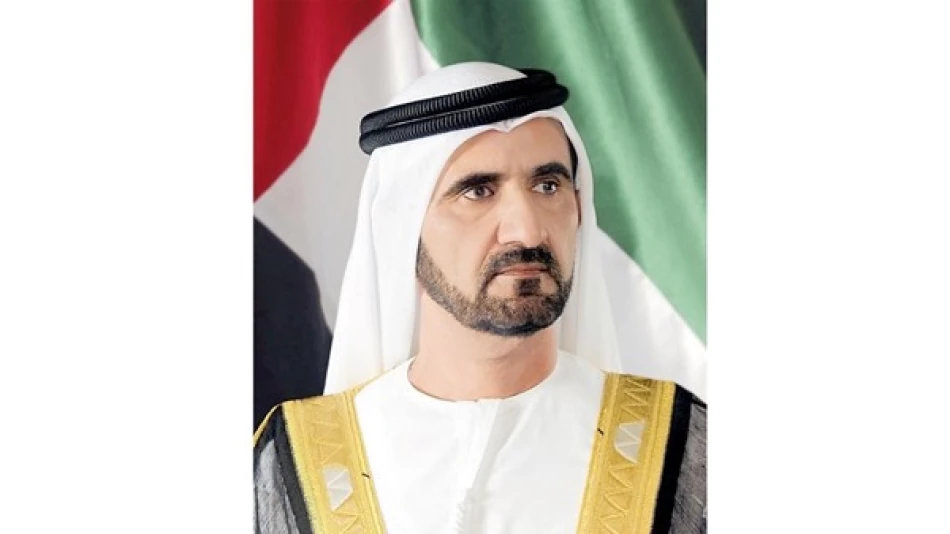
UAE's Unprecedented Growth Led by Crown Prince Mohammed bin Zayed, Reveals Dubai Ruler Mohammed bin Rashid
UAE's Non-Oil Trade Surge Signals Economic Diversification Success as Global Commerce Stagnates
The United Arab Emirates has achieved a remarkable 24% growth in non-oil foreign trade during the first half of 2024, vastly outpacing the global trade growth average of just 1.75%. With total non-oil trade reaching AED 1.7 trillion ($463 billion), the Gulf nation is demonstrating the success of its economic diversification strategy while positioning itself as a critical global trade hub amid worldwide commercial slowdown.
Record-Breaking Performance Across Key Markets
Dubai's ruler Sheikh Mohammed bin Rashid Al Maktoum announced the impressive figures, highlighting extraordinary growth rates with major trading partners that underscore the UAE's expanding global economic footprint. The country achieved a staggering 120% trade increase with Switzerland, 41% with Turkey, 33% with India, 29% with the United States, and 15% with China.
These numbers represent more than statistical success—they signal a fundamental shift in how the UAE engages with the global economy. The total non-oil trade volume has doubled in just five years, indicating sustained momentum rather than a temporary spike.
Strategic Positioning Amid Global Trade Headwinds
The UAE's performance becomes even more significant when viewed against the backdrop of sluggish global trade growth. While international commerce expanded by a modest 1.75%, the Emirates achieved growth rates more than 13 times higher, suggesting the country is capturing market share from competitors and establishing new trade corridors.
Diversification Strategy Paying Dividends
This surge validates the UAE's long-term strategy to reduce oil dependency, initiated over two decades ago. Unlike neighboring Gulf states that remain heavily reliant on hydrocarbon exports, the UAE has systematically built infrastructure, free zones, and regulatory frameworks that attract international businesses and facilitate trade flows.
The 120% jump in Swiss trade particularly stands out, likely reflecting increased flows in commodities trading, luxury goods, and financial services—sectors where both countries maintain competitive advantages.
Regional and Global Implications
The UAE's success contrasts sharply with economic challenges facing other regional powers. While Saudi Arabia pursues its Vision 2030 diversification plan and Qatar prepares for post-World Cup economic transitions, the UAE appears to have achieved sustainable non-oil growth momentum.
Investment and Market Opportunities
For international investors and multinational corporations, these figures signal robust demand within UAE markets and the country's effectiveness as a regional distribution hub. The strong performance across diverse markets—from Asia to Europe to North America—demonstrates the UAE's ability to facilitate trade regardless of geographic or economic bloc affiliations.
The dramatic growth with Turkey (41%) and India (33%) particularly highlights the UAE's role in South-South trade corridors, positioning it advantageously as global supply chains continue restructuring away from traditional Western-centric models.
Sustainable Growth or Cyclical Peak?
While the 24% growth rate appears exceptional, several factors suggest this performance may be sustainable rather than cyclical. The UAE's strategic location between Asia, Europe, and Africa, combined with world-class logistics infrastructure and business-friendly regulations, creates structural advantages that competitors struggle to replicate.
The doubling of trade volumes over five years indicates consistent policy execution rather than short-term gains. As global trade patterns continue evolving—particularly with increased regionalization and supply chain diversification—the UAE's neutral diplomatic stance and open economic model position it to capture additional market share.
However, sustaining such growth rates will require continued infrastructure investment and adaptation to changing global trade dynamics, including digital commerce integration and green economy transitions.
Most Viewed News

 Layla Al Mansoori
Layla Al Mansoori






